The importance of outdoor learning at Sunny Side Up
Research shows us that natural learning environments such as outdoor classrooms promote the quality and quantity of learning. The early learning years are critical to a child's development and will help establish a solid educational foundation for children as they continue to grow and learn. All children are natural born scientists who explore, investigate, seek evidence and try out cause and effect. These little scientists are discovering the textures, sights, sounds and scents of nature. Because of this the outdoor environment is inviting and easy to become engaged with, attracting the interests of children with varied learning styles and developmental abilities. This attraction to the natural environment is what trained teachers can hone in on in a way to set the stage for scaffolding children to higher levels of learning and new information.
Giving children the opportunity to explore and learn in a natural setting promotes things like holistic learning, risk taking, making connections, gross-motor and fine-motor skills, better social/emotional skills, deeper intellectual skills and so much more. Learning that comes through play is inviting and not at all intimidating which appeals to all learning styles.
Child centers should make great efforts to make an outdoor environment one which speaks to everyone who enters. Outdoor classrooms should be aesthetically pleasing to the mind and eye. Natural elements such as trees, different grasses, mulch, and flower gardens all allow for exploration as they grow and change through the seasons, as they move in the wind, as they droop in the rain, as they “die” in the winter. These areas also create homes for animals and insects allowing children to begin to realize that the world is not only about them, but how all living things play a part in our world. This is how empathy for others is developed, as we co-exist with nature. Include spaces with bird houses, nests and animal and insect habitats. Educators should bring stories outside to make connections from literature to real experiences.
The ideal outdoor learning environment should have a natural flow with pathways designated to areas such as an herb and vegetable garden where children can plant, grow, harvest and cook with homegrown foods. This opens up a plethora of investigation for life cycles, counting and sorting different seeds and plants, graphing and charting growth of plants, It provides opportunities for activities that stimulate all 5 senses, appealing to everyone on some level. The outdoor space should also be a safe area but it should not be contrived, it should be natural and allow for some risk taking. Teachers and children should bring materials from the inside out but also know the importance of putting things away, organization of materials, and taking care of spaces. Include signage that organize areas and that also teach with letters and numbers. For instance, a number on each stair, parking signs near the bikes, Plant identification markers, etc.
There should be calming and reflective spaces for things like wind chimes, whirligigs, wind socks and other wind movement items, perhaps even a water feature. Children should have access to both quiet spaces for retreating or relaxing and also larger spaces for running, jumping and making lots of noise. Spaces should be varied in natural elements such as rocks, pebbles, wood chips, stumps, water, sand for tactile experiences and investigations. These will stir inquiry such as “where does sand come from?” or “What will we see if we move this stump?” Examples like this creates a place and time for intentional problem solving.
Educators should also provide sparks for the little engineers of the world by utilizing outdoor blocks and having outdoor areas for construction and building. This could be with wood slabs, rocks, pine cones, sticks, etc. There should be places where science, technology, engineering and math actually make sense. An example of this could be trying to build a house that can withstand a wind storm in which you ask the kids to use materials to build a house that you think is strong. Then bring out a wind source like a fan and see which houses can stand. How would they change things to make them more sturdy?
Science is all around us in nature. It can easily be attractive and inviting by adding simple things like a bubble station, a magnet board or magnetic tracks where children can roll cars or balls to learn about gravity, centrifugal force, inclines, and more.
The arts should be fostered by providing musical areas with chimes, a gong, outdoor drums or xylophones. A space for dance and other large movement activities. Children should have access to things like clip boards, paper, markers, paint easels, clay, slate slabs and water for representations and artistic imagination. Books and props can be brought outside for acting out stories and plays.
And yes, we want children to go outside and exercise all their muscles when they run, jump, throw, ride bikes, slide, climb, crawl, hop, balance, roll, march, swing, and play, play, play! Healthy, well rounded children do much better in school.
Always take into consideration places that have shade and UV protection, places for tables or benches, protection from weather elements like tarps or umbrellas, natural storage areas, and of course a pleasant design. Now, get out there and play!

